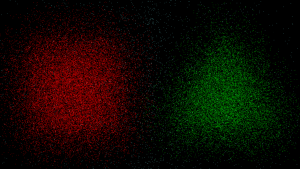The Synesthetic Speakeasy – Cycle 1 Proposal
Posted: October 9, 2016 Filed under: Uncategorized Leave a comment »For our first cycle I’d like to explore narrative composition and storytelling techniques in VR. I’m interested in creating a vintage speakeasy / jazz lounge environment in which the user passively experiences the mindsets of the patrons by interacting with objects that have significance to the person they’re associated with! This first cycle will likely be experimentation with interaction mechanics and beginning to form a narrative.
Peter’s Produce Pressure Project (2)
Posted: October 9, 2016 Filed under: Uncategorized Leave a comment »For our second pressure project, I used an Arduino (similar to a Makey-Makey) to allow for users to interact with a banana and orange as vehicles for generating audio. As the user touches a piece of fruit, a specific tone begins to pulse. Upon moving that fruit, it’s frequency increases with velocity. Then, if both pieces of fruit move quickly enough, geometric shapes on-screen explode! Once you let go of them, the shapes will reform into their geometric representations.
Our class’s reaction to the explosion was awesome; I wasn’t expecting it to be that great of a payoff 🙂
cycle 1 plans
Posted: October 4, 2016 Filed under: Uncategorized Leave a comment »Computer vision which tracks movement of 1 (maybe two) people moving in different quadrants (or some other word that doesn’t imply 4) of the video sensor (eyes or maybe use kinect to work with depth of movement as well), such that different combinations of movement trigger different sounds. (ie, lots of movement in upper half and stillness below triggers buzzing, reverse triggers a stampede or alternating up and down distal movement triggers sounds of wings flapping…. more to come if I can figure that out.
Pressure Project 2
Posted: October 4, 2016 Filed under: Uncategorized Leave a comment »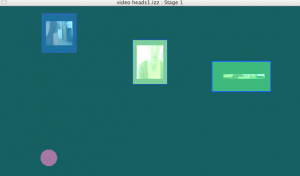
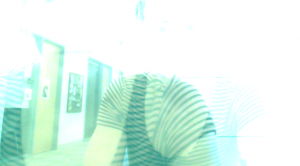
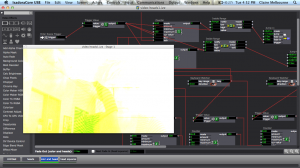

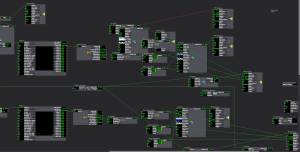 https://osu.box.com/s/7evtez7zjct0hg2ws4o9g2zlj04mb0qg
https://osu.box.com/s/7evtez7zjct0hg2ws4o9g2zlj04mb0qg
I started with a series of makey makey water buttons as a trigger for sounds and wanting to come up with different sequences of triggering to jump to different scenes. So if you touched the blue bowl of water then the green then yellow twice and then green again, through the calculator and inside range actors, you get moved to another scene. The made up the scenes trying to create variations on the colors and shapes that were part of the first scene, save for one, that was just 3 videos of the person interacting fragmented and layered with no sound. The latter was to make a interruption of sorts. BUT…. in practice, people triggered the water buttons so quickly that scenes didn’t have time to develop and the motion detection and interpretation from some of the scenes (affecting shape location and sound volume), didn’t become part of the experience. Considering now how to provide a frame for those elements to be more immediately explored, to slow people down in engaging with the water bowls whether via text or otherwise AND the possibility of a trigger delay to make time between each action.
Meta EVERYTHING – Performance and Media Taxonomy
Posted: September 27, 2016 Filed under: Uncategorized Leave a comment »I wanted to share a video with you all! A virtual reality researcher recorded himself with Kinects interacting with a computer program, entered that recording in the present, and interacted with what his past self was creating. The interaction is a here / there / virtual, now / then, and actor / prop / mirror / costume all bundled into one! It’s fascinating and I hope you all enjoy 🙂
Cheers,
Peter
Just Another Thing #2
Posted: September 22, 2016 Filed under: Uncategorized Leave a comment »I refound this today and though it is a bit old I re-fell in love. The Wilderness Downtown is not quite AR but not not AR. There is a magic in seeing things that are part of you on a screen, it somehow validates one’s experience as a human. A frame adds worth, which explains the grandiose self-portrait or even the home film. Anyways,
Anyways, so then I looked Chris milk up and found a TED talk (because there is a TED talk on everything). The talk is basically an exploration of his artistic trajectory. But he also talks about VR film and some fairly compelling storytelling applications.
VR and Taxonomy
Posted: September 22, 2016 Filed under: Uncategorized Leave a comment »The reading feels very pertinent to our feel at this point in time. Mixed media/multimedia/ new media is entering a level of popularity but literacy or even a concise lexicon has not entered the mainstream. This is a highly apparent when I had to write my resume this week. Am I a new media artist a digital systems designer, what? The reason I think that describing our art is that the processes are not apparent. When the painter paints there’s a one-to-one relationship between the active steering paint onto canvas and the act of seeing the paint that is been smeared. The reading makes a good point about the categorization but does not necessarily take into Account the viewers respectability of the process through the product.
As for the video on optical illusion and VR I found it very interesting but was not entirely sure what to take away from it.
I knew exactly what to take away from the AR video but was not sure I wanted to take it.
Finally, This week I started reading ready player one or rather listening to it so that I can actually function. The world it lays forward is super interesting. The physical plays second fiddle to virtual Space.
can i do anything to make it change?
Posted: September 19, 2016 Filed under: Uncategorized Leave a comment »https://osu.box.com/s/vwqcomm5zxzndy0ibt0vxro5xylqm6ah
I learned a ton from seeing folks’ processes and getting to experience other people’s projects. In particular, I’m beginning to have an inkling of how someone might animate an isolated square of a video.
city scape… it is pretty magical what audience can create.
people thought there were more interactive opportunities than there were because they were primed for it.
i realized i wanted to give more clues as to where to cause reactions, bigger reactions.
RSVP Cycles
Posted: September 17, 2016 Filed under: Reading Responses, Uncategorized Leave a comment »“Scores are symbolizations of processes.” I’ve been taught that process has a crucial importance in design education. Documenting and reflecting the process help the student and instructor to understand the possible improvements of the design piece. Therefore RSVP cycle of each project will affect the learning process and future work. For instance, the main focus of an MFA thesis is getting a documented score as an outcome. It might be a project, research or both but it should be documented with thesis writing. Resources should be analyzed through secondary research. Scores should be documented in order to show the process of getting the actual outcome and valuaction of process enhance the possible revisions of outcome. Finally performance is the documented thesis work and possible solution or the project itself. Learning from the process and also reflecting process is possible through RSVP cycle.
“Scores face the possible, goals face the impossible.” Also scores make the impossible possible because success requires time and improvement of process.
“Scores are ways of symbolizing reality of communicating experience through devices other than the experience itself.” Then I assume that the software is a score. Very interesting.
